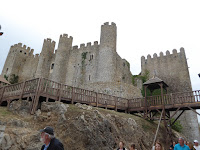 |
| Coimbra Jewish Quarter |
Coimbra (koy-EEM-bra)
Travel: Arriving at the Coimbra A train station, you pass by the newer city which is quite gross and should be avoided. Note that intercity trains arrive at the main Coimbra B train station, but all tickets include a free connecting train to Coimbra A (old city). We stayed at Hotel Vitoria which is a simple, clean and inexpensive hotel across from Coimbra A station and at the beginning of the older town. Turn right out of the hotel for good restaurants and a short walk into the lower (Baixa) city. We dropped off our rental car at Hertz near the bus station to avoid driving in Porto and Lisbon later in the trip.
 |
| Cafe Santa Cruz |
From Praca de Maio, explore the Mercado Municipal, a massive (and modern) market. Walk through the fish market at the end, exit to see the Elevador do Mercado (elevator/funicular) to the University area. [I couldn’t figure out the ticket machine, but you can pay the attendant cash).
 |
| University Main Gate |
 |
| University Courtyard |
Much of the University area was destroyed when the dictator Salazar “modernized” the University
area during his fascist regime. Fortunately he preserved the oldest part with the walls.
The courtyard, grand hall and King Joao’s Library are amazing. Reserve your Library tickets well in advance.
The downhill walk from the University takes you through winding streets with bars,
restaurants and music venues.
As you go through the former Jewish quarter you will pass the the ancient
Moorish Arco de Almedina back to the Rua de Ferreira Borges.
Obidos
On the drive from Evora to Coimbra, we stopped at the medieval town of Obidos (OH-bee-doosh). This is a beautiful little town, inside a 14th century wall, with a market street leading to a Moorish castle and fort. It was founded by the Celts around 300 BC, then ruled by Romans, Visigoths, Moors and finally the Portuguese. This is an amazing town worth a couple hours of exploring, although it’s only a 10 minute walk from the main gate to the castle. Be prepared for tourist crowds, it is reminiscent of Rottenburg Germany and Carcassonne France - medieval towns inundated by tour buses. This would make a great stop-over, arriving late (after the buses leave), staying at the hotel in the castle, then leaving early.
 |
| Main Gate |
 |
| Rua Direita |
Rua Direita is the main street leading from the main gate all the way to the Moorish Castle.
Lots of shops and restaurants along the way, as well on parallel streets.
Look for the book store in a former church near the end of the street, it’s beautiful inside.
Obidos has a strong literary tradition - in fact they were hosting a Literature exposition when we visited.
Make sure to get a €1 shot of Ginjinha in a chocolate cup from one of the vendors.
Ginjinha (sheen-SHEEN-yah) is a favorite sour cherry liqueur (especially in Lisbon),
dating back to medieval monks.
When returning to the main gate, walk back the quieter parallel streets or walk the town wall.
 |
| Obidos street |
 |
| View from Wall |
 |
| Moorish Castle |
 |
| St Mary Church |


No comments:
Post a Comment